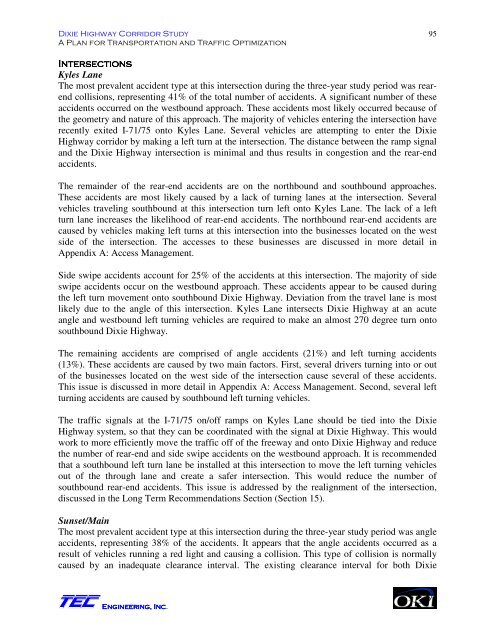11. Ac c iden t An al ysis Ac c iden t An al ysis - OKI
11. Ac c iden t An al ysis Ac c iden t An al ysis - OKI
11. Ac c iden t An al ysis Ac c iden t An al ysis - OKI
- No tags were found...
Create successful ePaper yourself
Turn your PDF publications into a flip-book with our unique Google optimized e-Paper software.
95" Kyles LaneThe most prev<strong>al</strong>ent acc<strong>iden</strong>t type at this intersection during the three-year study period was rearendcollisions, representing 41% of the tot<strong>al</strong> number of acc<strong>iden</strong>ts. A significant number of theseacc<strong>iden</strong>ts occurred on the westbound approach. These acc<strong>iden</strong>ts most likely occurred because ofthe geometry and nature of this approach. The majority of vehicles entering the intersection haverecently exited I-71/75 onto Kyles Lane. Sever<strong>al</strong> vehicles are attempting to enter the DixieHighway corridor by making a left turn at the intersection. The distance between the ramp sign<strong>al</strong>and the Dixie Highway intersection is minim<strong>al</strong> and thus results in congestion and the rear-endacc<strong>iden</strong>ts.The remainder of the rear-end acc<strong>iden</strong>ts are on the northbound and southbound approaches.These acc<strong>iden</strong>ts are most likely caused by a lack of turning lanes at the intersection. Sever<strong>al</strong>vehicles traveling southbound at this intersection turn left onto Kyles Lane. The lack of a leftturn lane increases the likelihood of rear-end acc<strong>iden</strong>ts. The northbound rear-end acc<strong>iden</strong>ts arecaused by vehicles making left turns at this intersection into the businesses located on the westside of the intersection. The accesses to these businesses are discussed in more detail inAppendix A: <strong>Ac</strong>cess Management.Side swipe acc<strong>iden</strong>ts account for 25% of the acc<strong>iden</strong>ts at this intersection. The majority of sideswipe acc<strong>iden</strong>ts occur on the westbound approach. These acc<strong>iden</strong>ts appear to be caused duringthe left turn movement onto southbound Dixie Highway. Deviation from the travel lane is mostlikely due to the angle of this intersection. Kyles Lane intersects Dixie Highway at an acuteangle and westbound left turning vehicles are required to make an <strong>al</strong>most 270 degree turn ontosouthbound Dixie Highway.The remaining acc<strong>iden</strong>ts are comprised of angle acc<strong>iden</strong>ts (21%) and left turning acc<strong>iden</strong>ts(13%). These acc<strong>iden</strong>ts are caused by two main factors. First, sever<strong>al</strong> drivers turning into or outof the businesses located on the west side of the intersection cause sever<strong>al</strong> of these acc<strong>iden</strong>ts.This issue is discussed in more detail in Appendix A: <strong>Ac</strong>cess Management. Second, sever<strong>al</strong> leftturning acc<strong>iden</strong>ts are caused by southbound left turning vehicles.The traffic sign<strong>al</strong>s at the I-71/75 on/off ramps on Kyles Lane should be tied into the DixieHighway system, so that they can be coordinated with the sign<strong>al</strong> at Dixie Highway. This wouldwork to more efficiently move the traffic off of the freeway and onto Dixie Highway and reducethe number of rear-end and side swipe acc<strong>iden</strong>ts on the westbound approach. It is recommendedthat a southbound left turn lane be inst<strong>al</strong>led at this intersection to move the left turning vehiclesout of the through lane and create a safer intersection. This would reduce the number ofsouthbound rear-end acc<strong>iden</strong>ts. This issue is addressed by the re<strong>al</strong>ignment of the intersection,discussed in the Long Term Recommendations Section (Section 15).Sunset/MainThe most prev<strong>al</strong>ent acc<strong>iden</strong>t type at this intersection during the three-year study period was angleacc<strong>iden</strong>ts, representing 38% of the acc<strong>iden</strong>ts. It appears that the angle acc<strong>iden</strong>ts occurred as aresult of vehicles running a red light and causing a collision. This type of collision is norm<strong>al</strong>lycaused by an inadequate clearance interv<strong>al</strong>. The existing clearance interv<strong>al</strong> for both Dixie !" .
















